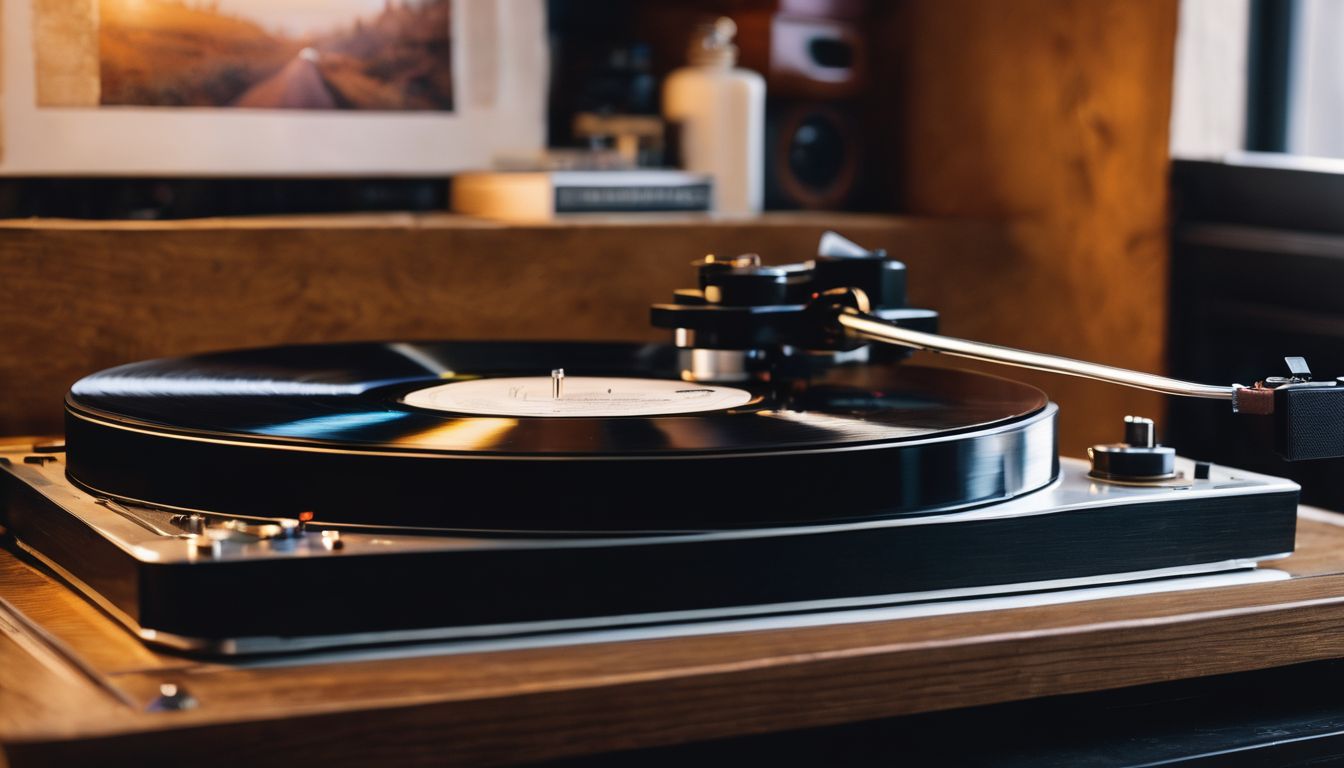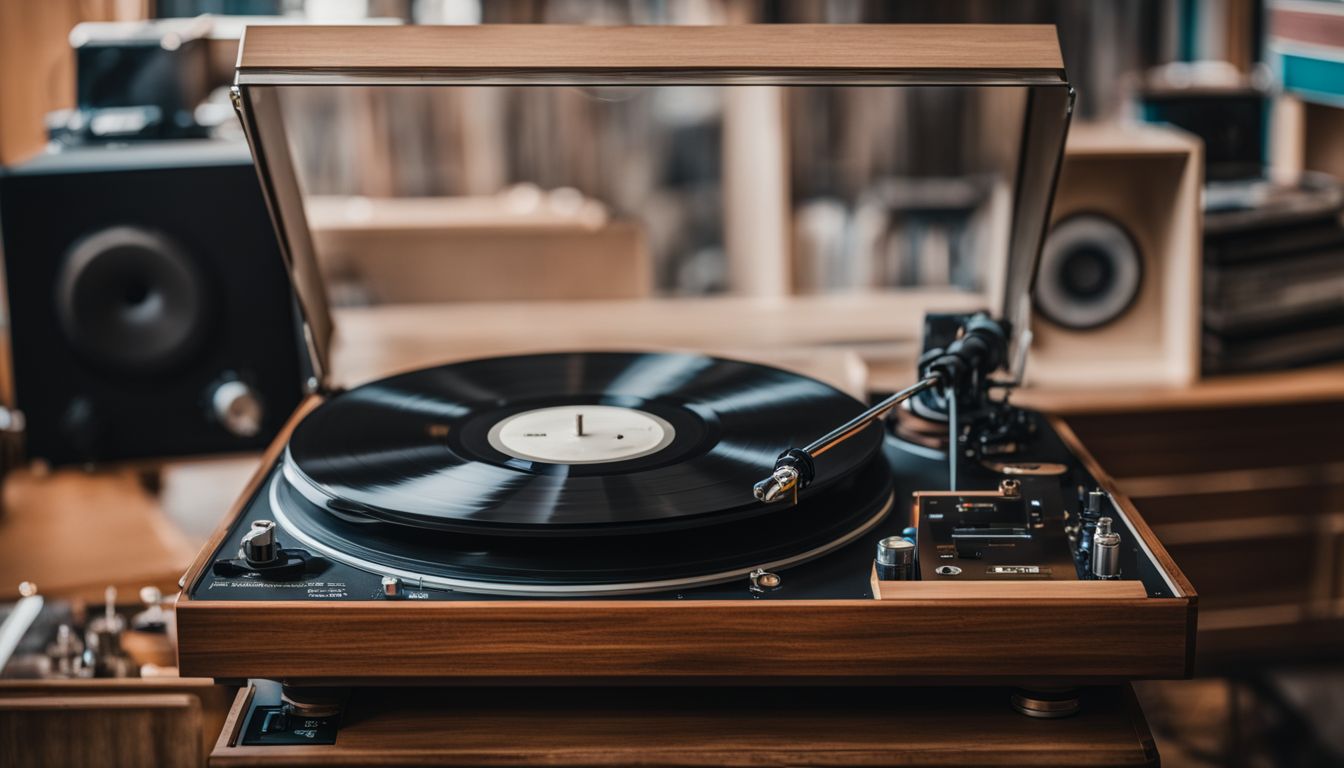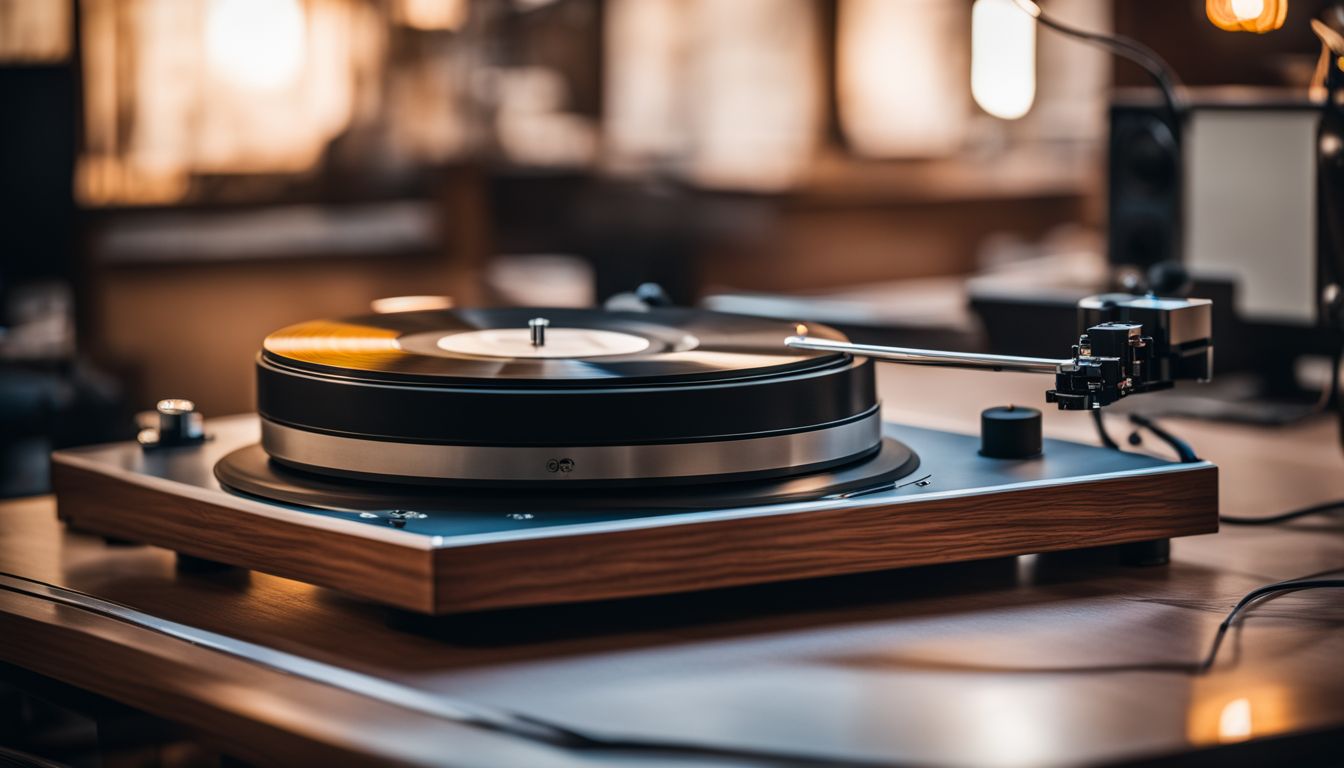Struggling to get your vinyl sounding just right? You might be overlooking a critical component of your record player: the phono stage. This unsung hero works behind the scenes, magnifying whispers from your vinyl into bold statements for your ears.
In this post, we’ll unravel the mystery of the phono stage and guide you to sonic bliss. Stay tuned; it’s about to sound even better.
Key Takeaways
- A phono stage, also known as a phono preamp, is essential for amplifying the low-level signal from a turntable’s cartridge to line level. This makes it possible for your audio system to process and play the sound.
- Audiophiles can get tailored sound quality with an external phono preamp. They can adjust the gain, which is not available in most built-in preamps.
- The type of cartridge on your turntable—either a moving magnet (MM) or a moving coil (MC)—determines the kind of phono stage needed. MC cartridges often require a specific preamp due to their lower signal output compared to MM cartridges.
- Compatibility with other audio components is vital when selecting a phono stage. It should match well with your amplifier and speakers. It should have suitable connections for seamless integration into your setup.
- Investing in a good-quality phono stage can significantly improve your vinyl listening experience. It enhances clarity, fidelity, and overall sound richness.
Understanding the Phono Stage on a Turntable
The phono stage plays a crucial role in bringing your vinyl records to life. Hidden within the grooves of a record lies an electrical signal that captures all the nuances of the music.
This signal is very faint, and without amplification, it can’t move speakers or headphones. Enter the phono stage: This audio component steps up to amplify these minute signals. It prepares them for further processing by your sound system.
Crafted with care, the phono stage delicately boosts the low-level output from moving magnet (MM) or moving coil (MC) cartridges. It does not simply make everything louder. Instead, it performs a precise act of balance. It does this using RIAA equalization—an essential curve. This curve restores fidelity to the original recording. It adjusts bass and treble levels correctly.
The final result is a line-level signal robust enough to flow through RCA cables without introducing noise or distortion. It can then reach receivers or powered speakers. Each turntable setup benefits from this pivotal piece. Whether you have built-in preamps will depend on personal preference and equipment compatibility. You may opt for separate units instead. Knowing its function is key to crafting your ultimate vinyl playback system.
Importance of a Phono Stage
A phono stage acts like a translator for your turntable. It converts the faint electrical signals into something a stereo system can work with. Without it, those tiny whispers from your vinyl LPs would stay unheard and the music’s full richness would be lost to silence.
A good phono preamp doesn’t just make the sound louder. It tweaks the audio through RIAA equalization to balance bass and treble. This is crucial for true-to-life tunes.
Recognize how this device enhances the clarity and specificity of every note that your record players play in order to comprehend it. It uses the signal levels originally meant for headphones or amplifiers. These amplifiers are specifically made for turntables—phono inputs. Then, it kicks them up to line level.
This is much like how a power amp energizes speakers but designed exclusively with vinyl in mind. Hi-fi systems deliver crisp, dynamic sounds with precise amplification. Audiophiles cherish them, ensuring every jam session at home feels like front-row seats at a live concert.
How a Phono Stage Converts Phono Signal to Line
A phono stage adeptly amplifies the delicate phono cartridge output. It applies the critical RIAA equalization curve. This transforms it into a line-level signal ready for your audio system. Continue reading to uncover its sophisticated process. Learn why it’s pivotal to extracting the purest sounds from your vinyl records.
Built-in Phono Preamps
Many turntables come equipped with built-in phono preamps. This means they’re ready to connect directly to your home audio system. These integrated preamps save you the hassle of purchasing an external device and allow for a more streamlined setup.
They amplify the signal from your moving magnet cartridge right inside the turntable. They also apply the necessary RIAA equalization curve to balance the sound. This feature is particularly beneficial if space is at a premium. It is also helpful if you prefer a simpler configuration. Additional components can clutter up your listening area.
Turntables with built-in phono preamps offer versatility. Some models include a switch that lets you bypass the internal preamp. This flexibility enables you to explore different external preamps in search of the perfect sound quality. You can also use the amplifier’s or receiver’s phono stage if it’s of higher quality than the built-in one.
You’ll find this option handy when upgrading your audio/video receiver or other parts of your home theatre system. It ensures that every nuance and detail of vinyl playback comes through clearly and accurately. It amplifies for full-range enjoyment.
External Phono Preamps
External phono preamps are standalone devices. They specialize in amplifying the signal from your turntable. They come into play for audiophiles who seek a higher grade of sound quality beyond what built-in preamps can provide.
These independent units connect between the turntable and power amplifier. They apply RIAA equalisation to accurately balance the frequencies of vinyl records.
Opting for an external phono preamp offers flexibility in tuning your audio experience. You could choose tube preamps for their warm sound signature or solid-state models with precise op-amps for clarity.
Moreover, these specialized devices often come with adjustable gain settings. The settings match perfectly with either moving magnet cartridges or moving coil cartridges. This ensures compatibility and optimizes performance.
Using an external device can significantly reduce unwanted noise and buzz. These devices have dedicated grounds separate from other components in your home theater setup.
External phono stages also have a better signal-to-noise ratio than internal ones. This is because they have isolated circuitry. This means the audio is crystal-clear and free of fuzz or interference.
External phono preamps cater to high-fidelity playback. They also accommodate various listening preferences and technical setups. They feature smart design and advanced features, like input impedance selectors. This includes compatibility with Pro-Ject Audio systems.
Is a Phono Stage the Same as a Phono Preamp?
Yes, a phono stage and a phono preamp refer to the same component. They amplify the signal from your turntable to make it compatible with modern amplifiers.
- “Phono stage” and “phono preamp” are terms that both describe an electronic circuit. This circuit boosts the low-level output from your record player.
- There are two types of phono stages. Some are built into turntables, and others are external and connect separately.
- The primary job of these devices is to equalize the audio signal using RIAA equalization. This process restores the sound’s natural balance lost during vinyl record production.
- Having a ground wire attached to your phono stage can minimize unwanted noise or hum in your system, ensuring cleaner playback.
- If you have a newer model CD player with analog inputs, you might not need an extra preamp since many include one already built-in.
- Invest in an external phano preamplifier if you desire higher-quality sound or if your turntable lacks a built-in option. External units can offer more features and customization for audiophiles.
Role of a Phono Stage for MC Cartridges vs MM Cartridges
Both MC (Moving Coil) and MM (Moving Magnet) cartridges interact with phono stages. However, their unique characteristics necessitate different approaches to amplification.
- MC cartridges generate a much weaker signal compared to MM cartridges. This often requires phonostages designed specifically for them. These specialized phono preamps provide higher gain to boost the low output without adding noise.
- The delicacy of an MC cartridge’s signal makes it more susceptible to distortion. A high-quality phono stage must present a lower noise floor that preserves the intricate details.
- Phono stages equipped with MM cartridges typically have standardized gain settings. These settings align closely with the moderate output levels produced by these more common types of cartridges.
- RIAA equalization is critical for both cartridge types but especially so for MC due to its nuanced audio profile. A superbly engineered equalizer corrects frequency imbalances. It ensures high-fidelity playback tailored for each cartridge type.
- Investing in a proper phono stage can reveal the full acoustic potential of an MC cartridge. It provides clarity and richness in sound that would otherwise be lost with inadequate amplification.
- MM cartridges are relatively robust and generate stronger signals. They are less finicky about the choice of phono preamp. They can perform well even with a standard built-in option found on many turntables.
The Impact of a Quality Phono Preamp
To surpass the sonic experience your turntable offers, selecting a high-quality phono preamp is crucial. It reveals nuances and depth that were previously obscured. It serves as the cornerstone for achieving an authentic vinyl sound. It ensures harmonious interplay with your entire audio system.
Sound Quality
Sound quality takes a leap forward with the right phono stage in your audio setup. A high-quality phono preamp extracts every nuance from vinyl records. It delivers a clarity that built-in options often miss.
It acts as an equalizer, smoothing out frequencies and ensuring your music sounds rich and full-bodied. Investing in a standalone phono stage can elevate even the most subtle instrumental details. It turns ordinary listening sessions into immersive experiences.
Match your turntable’s cartridge to a compatible phono stage for optimal performance. This is crucial for capturing the full sonic potential of your records. CD players and digital streams rely on different technologies to produce sound. Vinyl enthusiasts cherish the distinct warmth only a well-matched phono stage can provide.
By buffering and amplifying signals just right, it preserves the integrity of analog sound that so many music lovers seek.
Compatibility
Sound quality is a critical aspect of enjoying vinyl records. Ensuring your phono stage aligns with the rest of your audio setup is just as important. Select the right phono preamp by checking its compatibility with your turntable’s cartridge type. It could be MM (moving magnet) or MC (moving coil).
The connection between the turntable and the phono preamp uses audio cables. It’s vital that these cables are perfectly matched with both input and output jacks for seamless integration into your audio system.
Keep in mind that cable lengths should stay below 5 feet to preserve signal integrity.
Optimal compatibility extends beyond mere connections. It also influences how well all components work together to produce top-notch sound. Make sure the external phono preamp you choose can work with your turntable, amplifiers, and speakers.
The synergy across different elements of the audio chain plays a pivotal role. It creates an immersive listening experience with your favorite records.
Choosing the Right Phono Stage for Your Setup
Selecting the perfect phono stage for your turntable setup is a crucial step toward audiophile nirvana. It boosts performance and ensures that your vinyl collection sounds at its best. Here’s how you can choose the right one:
- Assess your turntable’s needs by determining if it has a built-in preamp. If not, you’ll need an external phonostage.
- Identify your cartridge type: moving magnet (MM) or moving coil (MC). Each requires a specific phonostage for optimal performance.
- Consider the equaliser settings available on potential phono stages. You can tailor sound reproduction to your preferences.
- Check if the phono stage is compatible with your other components, such as amplifiers and speakers.
- Consider whether you need USB outputs to record vinyl to digital.
- Evaluate reviews and specifications. Understand the sound quality improvements each phono preamp may offer.
- Establish a budget. Remember: investing in a higher-quality phono stage can significantly enhance the listening experience.
- Seek advice from seasoned audiophiles or trusted audio retailers. They can provide personalized recommendations based on your system and tastes.
Conclusion
In the world of vinyl, a phono stage plays a pivotal role. It transforms faint tunes from your records into robust sounds that fill the room with music as it was meant to be heard.
Remember, choosing the right phono stage means better harmonies and a richer listening experience. Carefully consider which phono preamp best suits your system’s needs. This will help your turntable setup reach its full potential.
Embrace high-fidelity sound by giving this unsung hero of audio equipment its due respect.
To ensure you’re getting the best sound from your vinyl, don’t forget to also learn about the importance of a record slip mat in your turntable setup.
FAQs
What exactly is a phono stage on a turntable?
A phono stage, also known as a preamplifier, boosts the low-level audio signal from your turntable. It makes the signal strong enough for your amplifier to process and play through speakers.
Why can’t I just plug my turntable directly into any amplifier or speaker system?
Most turntables need a phono stage because their signals are too weak. Without this specialized preamp, the music would be barely audible, even with volume turned up high.
Does every single turntable come with a built-in phono stage?
Not all of them do; some require an external one. You should check if your specific model has an integrated phono stage or if you’ll need to buy an additional component.
Will using a separate, dedicated phono stage make my records sound better?
Often yes! A separate high-quality phono stage can enhance audio clarity and detail compared to many built-in options. It lets you hear your vinyl at its best.


